Wai-Fah Chen.The Civil Engineering Handbook
Подождите немного. Документ загружается.

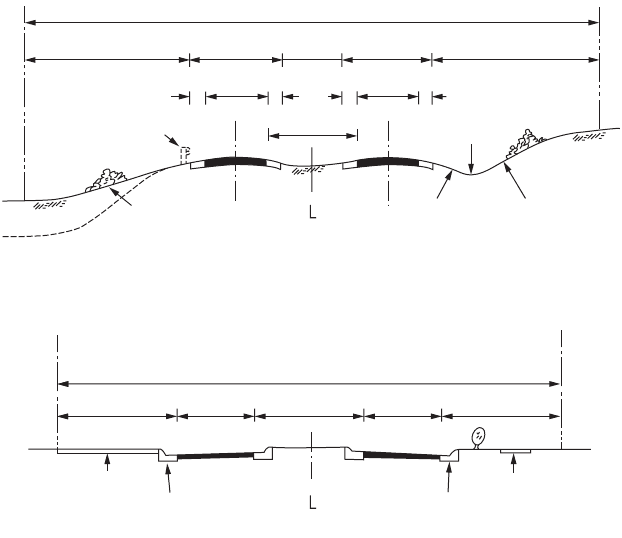
63-22 The Civil Engineering Handbook, Second Edition
slope ranging from 1.5 to 2% for high-type pavement surfaces, 1.5 to 3% for intermediate-type surfaces,
and 2 to 6% for low-type surfaces.
Shoulders
Shoulders vary in width from 2 to 12 ft and may be paved or unpaved. Some important advantages of
shoulders are providing a space for emergency stopping, maintenance operations, and signs; improving
sight distance and highway capacity; and providing a structural support for the pavement. Shoulder cross
slopes depend on the type of shoulder construction. Bituminous shoulders should be sloped from 2 to
6%, gravel shoulders from 4 to 6%, and turf shoulders about 8%. The designer should pay attention to
the difference between the pavement and shoulder cross slopes on horizontal curves. On the outside of
a superelevated section, the difference should not exceed 8%. On the inside, the shoulder and pavement
slopes are generally the same. Shoulder contrast is desirable and, when shoulders are used by bicycles,
pavement edge lines should be designed as described by the Manual on Uniform Traffic Control Devices
[FHWA, 1988].
Curbs
Curbs are used for several purposes, including drainage control, pavement edge delineation, esthetics,
and delineation of pedestrian walkways. They are used in all types of urban highways, but they are seldom
provided on rural highways. The two common types of curbs are barrier curbs and mountable curbs.
Barrier curbs have relatively steep faces, designed to prevent vehicles from leaving the roadway. They are
used on bridges, piers, and sidewalks, but they should not be used where the design speed exceeds 40 mph,
because of the difficulty to retain control of the vehicle after an impact with the curb. Mountable curbs
have flat sloping faces, designed to allow vehicles to cross over if required. They are used at median edges,
at shoulder inside edges, and to outline channelizing islands at intersections. Barrier and mountable
curbs may include a gutter that forms the drainage system for the roadway.
FIGURE 63.12 Typical cross sections for rural highways and urban streets.
Right-of-way
Roadside Roadway Roadway
Guardrail
Median
Drainage
channel
Cut
SSSS
T
T
Sideslope
Sideslope
Backslope
(a) Rural Highways
S = Shoulder
T = Traveled way
Fill
Right-of-way line
Right-of-way line
Right-of-way line
Median
TT
Right-of-wayCommercial Residential
BorderBorder
Sidewalk
Curb & gutter Curb & gutter
Sidewalk
(b) Urban Streets
Roadside
c
c
Right-of-way line
© 2003 by CRC Press LLC
Geometric Design 63-23
Medians
A median is the portion of a divided highway separating opposing traveled ways. The median width is
the distance between the inside-lane edges, including the left shoulders, as shown in Fig. 63.12. The
median is primarily provided to separate opposing traffic, but it also provides a recovery area for out-
of-control vehicles, a stopping area during emergencies, a storage area for left-turning and U-turning
vehicles, and a space for future lanes. Median widths range from a minimum of 4 to 80 ft or more. Wider
medians are desirable, but they may lead to inefficient signal operation at intersections. Medians can be
depressed, raised, or flushed, depending on width, treatment of median area, and drainage arrangements.
A median barrier (a guardrail or a concrete wall) must be considered on high-speed or high-volume
highways with narrow medians and on medians with obstacles or a sudden lateral dropoff.
Sideslopes and Backslopes
On fills, sideslopes provide stability for the roadway and serve as a safety feature by being part of a clear
zone. In cuts, sideslopes and backslopes form the drainage channels. Sideslopes of 4:1 or flatter are
desirable and can be used where the height of a fill or cut is moderate. Sideslopes steeper than 3:1 on
high fills generally require roadside barriers. Backslopes should be 3:1 or flatter to facilitate maintenance.
Steeper backslopes should be evaluated for soil stability and traffic safety. In rock cuts, backslopes of 1:4
or vertical faces are commonly used. Rounding where slope planes intersect is an important element of
safety and appearance.
Clear Zones
The clear zone is the unobstructed, relatively flat area outside the edge of the traveled way, including
shoulder and sideslope, for the recovery of errant vehicles. The clear zone width depends on traffic
volume, speed, and fill slope. Where a hazard potential exists on the roadside, such as high fill slopes,
roadside barriers should be provided. The Roadside Design Guide [AASHTO, 1996] provides guidance
for design of clear zones, roadside barriers, and sideslopes and backslopes.
Intersections
There are three general types of intersections: at-grade intersections, grade separations without ramps,
and interchanges. Selection of a specific intersection type depends on several factors, including highway
classification, traffic volume, safety, topography, and highway user benefits. Selection guidelines based
on highway classification are given in Table 63.9.
At-Grade Intersections
The objective of intersection design is to reduce the severity of potential conflicts between vehicles,
bicycles, and pedestrians. Intersection design is generally affected by traffic factors, physical factors,
human factors, and economic factors. Examples of these factors are turning-movement design volumes,
sight distance, perception–reaction time, and cost of improvements. There are four basic types of at-
grade intersections: three-leg intersections, four-leg intersections, multileg intersections, and round-
abouts. The key features of intersection design include capacity analysis, alignment and profile, turning
curve radius and width, channelization, median opening, traffic control devices, and sight distance.
Details on these design features, along with examples of good designs, are given by AASHTO.
Modern Roundabouts
Modern roundabouts, which have been used less in North America than abroad, differ from the tradi-
tional traffic circles or rotaries that have been in use for many years. AASHTO defines two basic principles
for modern roundabouts. First, vehicles on the circulatory roadway of the roundabout have the right-
of-way, and entering vehicles on the approaches have to wait for a gap in the circulating traffic. Yield
signs are used at the entry control. Modern roundabouts are not designed for weaving maneuvers, thus
permitting smaller diameters. Second, the centerlines of the entrance roadways intersect at the center of
© 2003 by CRC Press LLC
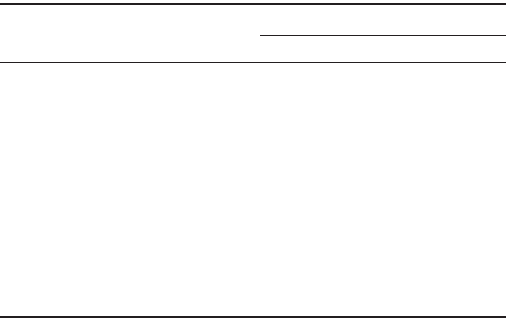
63-24 The Civil Engineering Handbook, Second Edition
the roundabout island. Thus, entering traffic is deflected to the right by the central island and by
channelization at the entrance.
Rigid objects in the central island, such as monuments, should be avoided because they may pose a
safety concern. Instead, esthetic landscaping of the central island and the splitter islands is frequently
used. In this case, however, consideration should be given to driver’s sight distance needs. There is growing
interest in modern roundabouts in the United States, due partially to their success in Europe and Australia.
A recent survey showed that the United States has fewer than 50 modern roundabouts, in contrast to
15,000 in France. Current practice and experience with modern roundabouts can be found in a recent
NCHRP synthesis [Jacquemart, 1998].
Railroad–Highway Grade Crossings
Horizontal and vertical alignments of a highway approaching a railroad grade crossing require special
attention. For horizontal alignment, the highway should intersect the track at a right angle. This layout
aids the driver’s view of the crossing and reduces conflicting vehicular movements from crossroads and
TABLE 63.9 Selection of Interchanges, Grade Separations,
and Intersections Based on Classification
Intersecting Roads
Consideration Based on Classification
Rural Urban
Freeway/freeway A A
Freeway/expressway — A
Freeway/arterial B C
Freeway/collector or local D E
Expressway/expressway — A
Expressway/arterial — F
Expressway/collector or local — G
Arterial/arterial H H
Arterial/collector or local I H or I
Collector or local/collector or local J J
Note:
A = Interchange in all cases.
B = Normally interchange, but only grade separation where traffic volume
is light.
C = Normally interchange, but only grade separation where interchange
spacing is too close.
D = Normally grade separation; alternatively, the collector or local may be
used.
E = Normally grade separation, but an interchange may be justified to
relieve congestion and serve high-density traffic generators.
F = Normally interchange or intersection; refer to C or G.
G = Normally grade separation, but an intersection may be justified to
relieve congestion and serve high-density traffic generators.
H = Normally intersection, but an interchange may be justified where
capacity limitation causes serious delay, injury and fatality rates are
high, cost is comparable to an intersection, or one arterial may be
upgraded to a freeway in the future.
I = Normally intersection; alternatively, the collector or local may be
closed.
J = Normally intersection; alternatively, one road may be closed.
Source: Transportation Association of Canada, Geometric Design Guide for
Canadian Roads, Ottawa, Ontario, 1999. With permission of the Transportation
Association of Canada, www.tac-atc.ca.
© 2003 by CRC Press LLC

Geometric Design 63-25
driveways. A right-angle crossing is also preferred for bicyclists because the more the crossing deviates
from the ideal 90°, the greater the potential for a bicycle’s wheel to be trapped in the flangeway. Crossings
should not be located on highway or railroad curves. A roadway curvature may direct a driver’s attention
toward negotiating the curve instead of the crossing ahead, while a railroad curvature may inhibit the
driver’s view down the tracks. Crossings with both highway and railroad curves create maintenance
problems due to conflicting superelevations.
For vertical alignment, the crossing should be as level as practical to aid sight distance, rideability,
braking, and acceleration distances. For crossings without train-activated warning devices, the sight
distance should be adequately designed for moving vehicles to safely cross or stop at the railroad crossing
and for vehicles to depart from a stopped position at the crossing [AASHTO, 2001].
Intersection Sight Distance
The intersection sight triangle (specified legs along the intersection approaches and across their included
corners) must be clear of obstructions that might block the driver’s view of potentially conflicting vehicles.
The dimensions of the legs of the sight triangle depend on the design speeds of the intersecting roadways
and the type of traffic control at the intersection. Two types of sight triangles are considered in intersection
design: approach sight triangle and departure sight triangle.
For approach sight triangles, the lengths of the legs should be such that the drivers can see any
potentially conflicting vehicles in sufficient time to slow or stop before colliding within the intersection.
Typical approach sight triangles to the left and to the right of a vehicle approaching an uncontrolled or
yield-controlled intersection are shown in Fig. 63.13A. Note that approach sight triangles are not needed
for intersection approaches controlled by stop signs or traffic signals. For departure sight triangles, the
clear sight triangle provides a sight distance sufficient for a stopped driver on the minor-road approach
to depart from the intersection and enter or cross the major road. Typical departure sight triangles to
the left and to the right for a stopped vehicle on the minor road are shown in Fig. 63.13B. Departure
sight triangles should also be provided for some signalized intersection approaches. The dimensions of
the sight triangles recommended in AASHTO are based on assumptions derived from field observations
of driver gap-acceptance behavior.
The surface of the sight triangle is established using a driver’s eye height of 3.5 ft and an object height
of 3.5 ft above the roadway surface. Clearly, the horizontal and vertical alignments of the intersecting
roadways should be considered. An object within the sight triangle will constitute an obstruction if its
height is larger than the respective height of the sight triangle. The sight triangle is used to determine
required building setbacks, to find whether an existing obstruction should be moved, and to determine
appropriate traffic control measures if the obstruction cannot be moved.
AASHTO presented the following cases of intersection sight distance that depend on the type of
intersection control: intersection with no control (case A), intersection with stop control on the minor
road (case B), intersection with yield control on the minor road (case C), intersection with traffic signal
control (case D), intersection with all-way stop control (case E), and left turns from the major road (case
F). For cases B and C, consideration is given to whether the vehicle on the minor road is turning left,
turning right, or crossing. As an illustration, case B1 (left turn from stop control) is discussed.
Case B1
For this case, the dimensions of the sight triangle (a and b in Fig. 63.13 B) are determined as follows.
The length of the sight triangle along the minor road, a, equals the sum of the following distances:
(1) distance from the driver’s eye to the front of the vehicle (8 ft for passenger cars), (2) distance from
the front of the vehicle to the edge of the major-road traveled way (6.5 ft), and (3) distance from the
edge of the major-road traveled way to the path of the major-road vehicle (0.5-lane width for vehicles
approaching from the left or 1.5 lanes for vehicles approaching from the right).
The length of the sight triangle along the major road, b, is given by
(63.11)
ISD V t
g
= 147.
major
© 2003 by CRC Press LLC
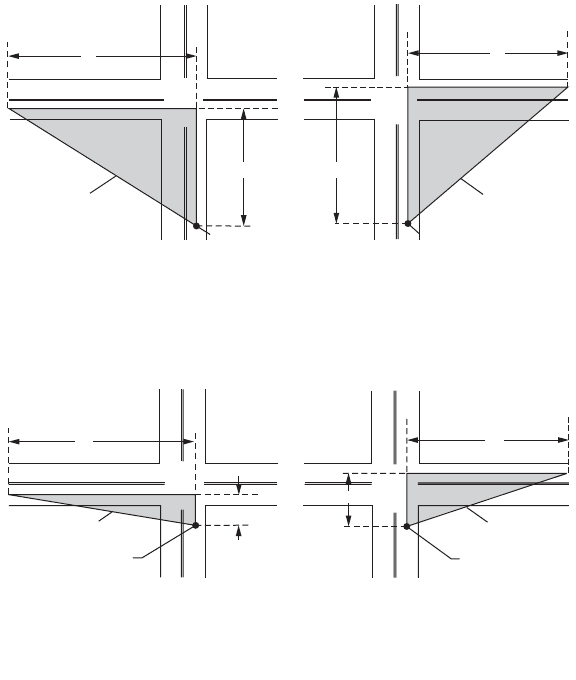
63-26 The Civil Engineering Handbook, Second Edition
where ISD = the intersection sight distance (length of the edge of the sight triangle along the major
highway (ft))
V
major
= the design speed of the major road (mph)
t
g
= the time gap for the minor-road vehicle to enter the major road (sec)
Based on field observations, t
g
equals 7.5 sec for passenger cars, 9.5 sec for single-unit trucks, and
11.5 sec for combination trucks. These values are for a stopped vehicle to turn right or left onto a two-
lane highway with no median and grades 3% or less. Adjustments to the gap times for different numbers
of lanes of the major road and different approach grades of the minor road are provided by AASHTO.
Based on Eq. (63.11), Fig. 63.14 shows the required sight distance along the major road.
The gap-acceptance approach of ISD presented above is based on an NCHRP report by Harwood et al.
[1996]. Special cases of intersection sight distance have also been examined. Mason et al. [1989] discussed
ISD requirements for large trucks. Gattis [1992] and Gattis and Low [1998] studied sight distance for
intersections at other than 90°. Easa [2000] presented a reliability approach to intersection sight distance.
Example 63.6
A four-lane undivided major road with a 60-mph design speed intersects with a minor road controlled
by a stop sign. Calculate the lengths of the sight triangle at this intersection for passenger cars turning
FIGURE 63.13 Intersection sight triangles. (From AASHTO, A Policy on Geometric Design of Highways and Streets,
Washington, D.C., 2001. With permission.)
Clear sight triangle
A – Approach Sight Triangles
B – Departure Sight Triangles
Decision point
Clear sight triangle for viewing
traffic approaching from the right
Decision point
Clear sight triangle
Clear sight triangle for viewing
traffic approaching from the left
a
b
b
a
Major road
Minor road
Major road
Minor road
Clear sight triangle
Decision point
Clear sight triangle for viewing
traffic approaching from the right
Decision point
Clear sight triangle
Clear sight triangle for viewing
traffic approaching from the left
a
b
b
a
Major road
Minor road
Major road
Minor road
© 2003 by CRC Press LLC
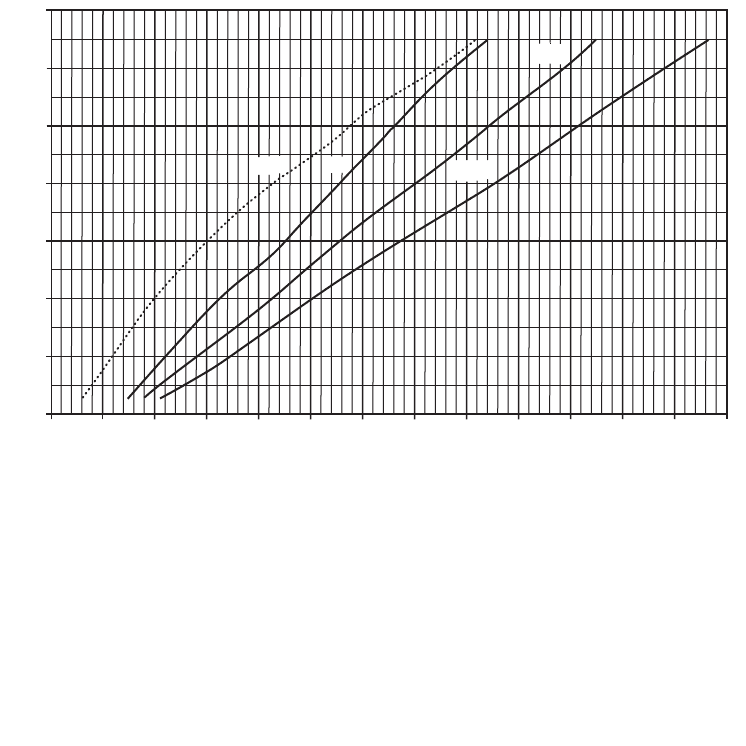
Geometric Design 63-27
left from the minor road. Assume 12-ft lanes and a 4% upgrade on the minor road. First, compute a =
8 + 6.5 + 18 = 32.5 ft. For passenger cars, t
g
=
7.5 sec. According to AASHTO, the time gap is increased
by 0.5 sec for passenger cars for each additional lane in excess of one to be crossed by the turning vehicle.
For a four-lane undivided road, the turning vehicle will need to cross two near lanes, rather than one,
thus increasing the time gap from 7.5 to 8.0 sec. Also, the time gap needs to be increased by 0.2 sec for
each percent upgrade of the minor road. This brings the final value of t
g
to 8.8 sec. Thus, Eq. (63.11) gives
Suppose that an existing building that cannot be moved restricts the sight distance along the major
highway to 660 ft. To make the intersection sight distance adequate, the speed of the major road may be
reduced. Substituting for ISD = 660 in Eq. (63.11) gives the required speed on the major highway as
V
major
= 51.0 mph, say 50 mph.
Adequate sight distances should also be provided at railroad–highway grade crossings without train-
activated warning devices. Two sight distance cases for moving and stopped vehicles are described by
AASHTO. Although the 85th-percentile speed of vehicles is normally used in traffic analysis, the 15th-
percentile speed should be used for the moving vehicle case [Easa, 1993a].
Interchanges
Interchanges provide the greatest traffic safety and capacity. The basic types of interchanges are shown in
Fig. 63.15. The trumpet pattern provides a loop ramp for accommodating the lesser left-turn volume. The
three-leg directional pattern is justified when all turning movements are large. The one-quadrant inter-
change is provided because of topography, even though the volumes are low and do not justify the structure.
Simple diamond interchanges are most common for major–minor highway intersections with limited right-
of-way. A full-cloverleaf interchange is adaptable to rural areas where the right-of-way is not prohibitive,
while a partial-cloverleaf interchange is normally dictated by site conditions and low turning volumes. An
all-direction four-leg interchange is most common in urban areas where turning volumes are high.
FIGURE 63.14 Intersection sight distance. Case B1: left turn from stop. (From AASHTO, A Policy on Geometric
Design of Highways and Streets, Washington, D.C., 2001. With permission.)
80
70
60
50
40
30
20
10
0 100 200 300 400 500 600 700 800 900 1000 1100 1200 1300
Length of Sight Triangle Leg (ft)
Design Speed (mph)
COMB
SU
SSD
PC
ISD =¥¥=147 6088776 2...ft
© 2003 by CRC Press LLC
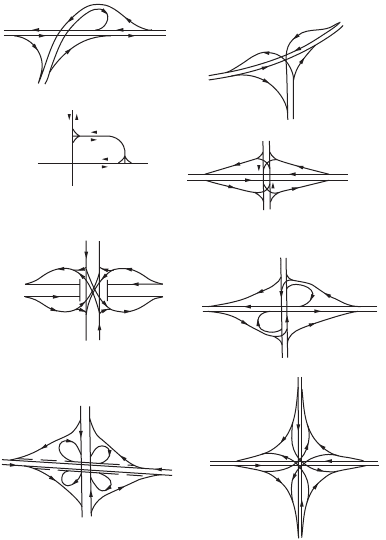
63-28 The Civil Engineering Handbook, Second Edition
In urban areas, where the interchanges are closely spaced, all interchanges should be integrated into
a system design that includes the following aspects: (1) interchange spacing, (2) route continuity,
(3) uniformity of exit and entrance patterns, (4) signing and marking, and (5) coordination of lane
balance and basic number of lanes. Details on these design aspects are presented by AASHTO.
High-occupancy vehicle (HOV) roadways, designated for buses and carpools (typically with three or
more persons per vehicle), have been incorporated into urban freeway corridors to improve traffic
operations. There are three basic types of HOV lanes. The concurrent-flow type provides an HOV lane
normally on the left lane of the roadway in both directions. The HOV lane is separated from the regular-
use lanes with a buffer. The contra-flow type designates an HOV lane in the opposing direction of travel.
The third type involves physically separating the HOV lane. Details on the design of HOV facilities are
given in the Guide for the Design of High-Occupancy Vehicle Facilities [AASHTO, 1992a].
Esthetic and General Considerations
Exact adherence to the preceding (specific) design guidelines does not guarantee obtaining a satisfactory
and esthetically pleasing design. A number of general guidelines should also be followed in practice for
individual horizontal and vertical alignments, combined alignments, and cross sections and intersections.
Individual Alignments
For horizontal alignment, the alignment should be as directional as possible but should conform to the
natural contours. The designer should avoid the use of a minimum radius, small deflection angles, sharp
curves at the end of long tangents, an abrupt reversal in alignment, and broken-back curves. If small
deflection angles cannot be avoided, curves should be sufficiently long to avoid the appearance of a kink.
For compound curves, the ratio of the flatter radius to the sharper radius should not exceed 1.5.
FIGURE 63.15 Interchange configurations. (From AASHTO, A Policy on Geometric Design of Highways and Streets,
Washington, D.C., 2001. With permission.)
TRUMPET
- A -
THREE LEG
DIRECTIONAL
- B -
DIAMOND
- D -
ONE QUADRANT
- C -
- E -
SINGLE-POINT
URBAN INTERCHANGE
- F -
PARTIAL
CLOVERLEAF
FULL
CLOVERLEAF
ALL DIRECTIONAL
FOUR LEG
- H -
- G -
© 2003 by CRC Press LLC
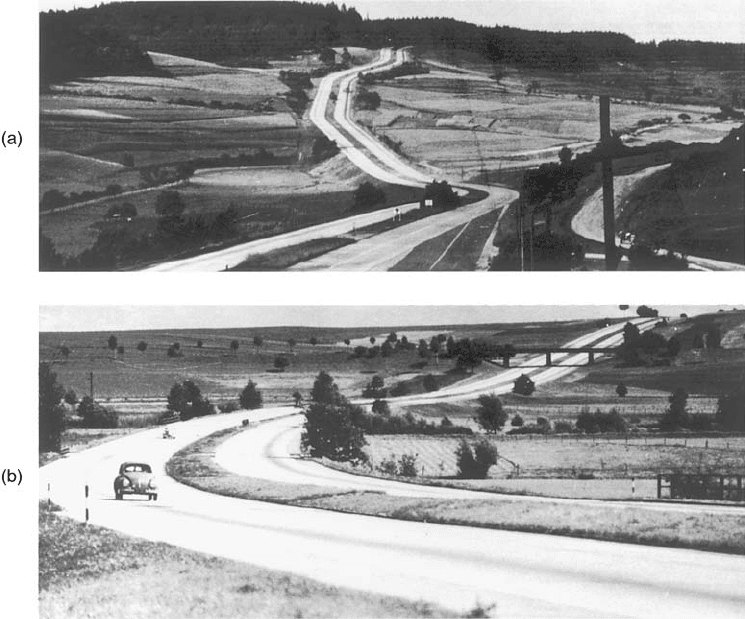
Geometric Design 63-29
For vertical alignment, a smooth-flowing profile is preferred to a profile with numerous breaks and
short grades. The designer should avoid the hidden-dip type of profiles, broken-back curves, sag vertical
curves in cuts, and crest vertical curves on fills. On long grades, the steepest grade should be placed at
the bottom, and the grades near the top of the ascent are lightened. Steep grades through important
intersections should also be reduced to minimize potential hazards to turning vehicles.
Combined Alignments
Coordination of horizontal and vertical alignments can be achieved during both preliminary location
study and final design. A change in horizontal alignment should be made at a sag vertical curve where
the driver can readily see the change in direction. However, to avoid distorted appearance, sharp hori-
zontal curves should not be introduced near the low point of the sag vertical curve. If combined horizontal
and crest vertical curves cannot be avoided, the horizontal curve should lead the vertical curve. Providing
adequate passing opportunities on two-lane highways should supercede other desirable combinations of
horizontal and vertical alignments. Alignment coordination is aided by using computer perspectives.
Figures 63.16 and 63.17 show two examples of poor and good practice.
Cross Sections and Intersections
Esthetic features of cross section design include well-rounded sideslopes and backslopes, tapered piers
and planting below elevated freeways, and spandrel arch bridges where excess vertical clearance is avail-
able. On depressed freeways, planting on median barriers, textured retaining walls with luminaire located
FIGURE 63.16 Example of highways with (a) a long tangent that slashes through the terrain and (b) the more
desirable flowing alignment that conforms to the natural contours. (From Transportation Association of Canada,
Geometric Design Guide for Canadian Roads, Ottawa, Ontario, 1999. With permission of the Transportation Associ-
ation of Canada, www.tac-atc.ca.)
© 2003 by CRC Press LLC
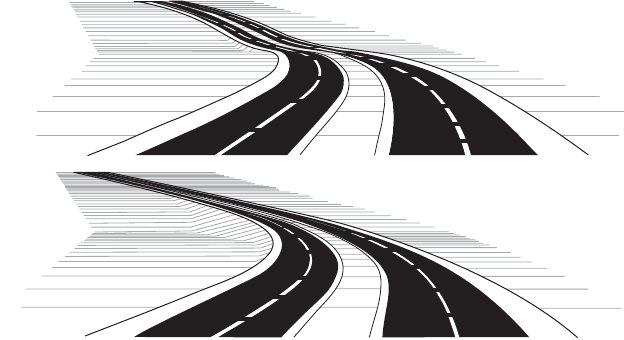
63-30 The Civil Engineering Handbook, Second Edition
on the top, and landscape planting on the earth slopes aid the roadway appearance. At interchanges, flat
earth slopes and long transition grading between cut and fill slopes raise the esthetic level of the area.
Landscape development on roadsides and at interchanges is an important design feature for esthetics
and safety. Information on the subject is found in Transportation Landscape and Environmental Design
[AASHTO, 1992b].
Design Aids
A number of design aids are used in geometric design, including physical aids and computer programs.
These design aids provide greater flexibility and efficiency during various stages of highway design.
Physical aids include templates and physical models. The following types of templates are used in
geometric design: horizontal curve, vertical curve, turning vehicle, and sight distance. Horizontal curve
templates may be circular curves, three-centered curves, or spiral curves, while vertical curve templates
are parabolic. Both types of templates are used in preliminary location study and final design. Turning
vehicle templates for design vehicles are used to establish the minimum vehicle path and minimum
pavement width for different turning conditions [ITE, 1993].
Sight distance templates are used to measure the available sight distances graphically on highway plans
and profiles, especially in a preliminary location study. Each template consists of four parallel horizontal
lines. The top line represents the line of sight and the next three lines represent the profile elevations for
object height, driver’s eye height, and opposing vehicle height, respectively. Physical models are skele-
tonized, scaled structures easily adjusted to required changes in alignment (design models) or permanent
structures used to illustrate the functional plan of a highway or interchange (presentation models).
Computer software is available to carry out all (or specific) aspects of highway geometric design.
Available microcomputer programs are regularly published by the Center for Microcomputers in Trans-
portation [McTrans, 1993]. For example, Interactive Computer Assisted Highway Design (ICAHD) is a
comprehensive rural highway design program for microcomputers that is used for all geometric design
aspects. A sister program, ICAHD Urban Design Model, allows for the design of urban streets and
highways. AutoTURN is used for simulating a vehicle turning path in a computer-aided design environ-
ment, and SPUI is used for analyzing the geometric design of single-point urban interchanges.
FIGURE 63.17 Example of highway perspectives with (a) a short vertical curve imposed on a relatively long hori-
zontal curve, causing the appearance of a settlement of the roadway, and (b) the more desirable alignment where
the length of vertical curve is increased to nearly that of the horizontal curve. (From Transportation Association of
Canada, Geometric Design Guide for Canadian Roads, Ottawa, Ontario, 1999. With permission of the Transportation
Association of Canada, www.tac-atc.ca.)
(a)
(b)
© 2003 by CRC Press LLC
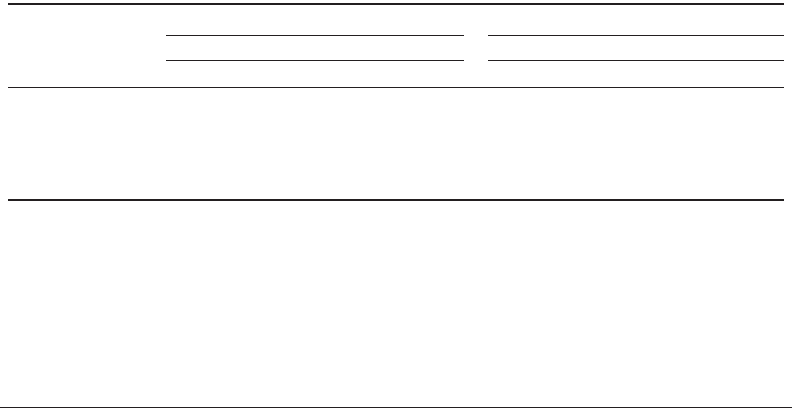
Geometric Design 63-31
63.4 Special Design Applications
Special design applications include complex highway curves, three-dimensional alignments, sight distance
needs for trucks, and resurfacing, restoration, and rehabilitation projects. Design considerations for these
special applications have been recently addressed in the literature and, to a large extent, they supplement
the design aspects covered by the AASHTO and TAC guides.
Complex Highway Curves
Complex highway curves consist of two consecutive circular or parabolic curves. Sight distance charac-
teristics of these curves are different from those of simple curves and, consequently, design requirements
are different. Four types of complex curves are discussed: unsymmetrical vertical curves, compound
curves, reverse curves, and highway sight-hidden dips (SHDs).
Unsymmetrical Vertical Curves
Unsymmetrical vertical curves may be required on certain occasions because of vertical clearance or other
controls. An unsymmetrical vertical curve consists of two consecutive (unequal) parabolic curves with
a common tangent at VPI. The curve is described by the parameter Q, which is the ratio of the shorter
curve to the total curve length. Design length requirements for unsymmetrical crest and sag vertical
curves, based on AASHTO sight distance needs, have been developed. Table 63.10 shows the minimum
length requirements for crest and sag vertical curves for Q = 0.4. The length requirements for unsym-
metrical vertical curves are much greater than those for simple vertical curves.
Recent research has attempted to increase the smoothness and flexibility of unsymmetrical vertical
curves. An unsymmetrical vertical curve with two equal arcs has been developed [Easa, 1994a; Easa and
Hassan, 1998]. This curve not only is smoother but also improves sight distance, comfort, and esthetics,
compared with the traditional unsymmetrical curve. When simple and two-arc unsymmetrical vertical
curves cannot satisfy vertical clearance constraints, another type of unsymmetrical vertical curve with
three arcs can be used [Easa, 1998].
Compound Horizontal Curves
Compound horizontal curves are advantageous for turning roadways at intersections and interchanges
and on open highways, and they are more economical in mountainous terrain. A compound curve
consists of two consecutive horizontal curves with different radii turning in the same direction. For
TABLE 63.10 Design Length Requirements for Unsymmetrical Crest and Sag Vertical Curves Based on SSD
of AASHTO (Q = 0.4)
Algebraic
Difference in Grades
(%)
Minimum Length of Crest Vertical Curve (ft)
a
Length of Sag Vertical Curve (ft)
b
Design Speed (mph) Design Speed (mph)
20 30 40 50 60 70 20 30 40 50 60 70
2
4
6
8
10
50
50
50
90
120
70
80
170
250
270
100
180
240
420
530
120
470
630
840
1210
330
980
1190
1870
2230
580
1360
1840
2360
3230
60
60
140
220
280
90
160
300
440
550
120
340
600
830
1010
150
560
970
1310
1650
180
820
1410
1880
2380
210
1130
1920
2580
3220
a
Driver’s eye height = 3.5 ft; object height = 2.0 ft; a = 1°.
b
Headlight height = 2 ft.
Source: For minimum length of crest vertical curve: Easa, S.M., Sight distance model for unsymmetrical crest curves,
Transp. Res. Rec., 1303, 46, 1991. Note: Values in this reference are based on a 0.5-ft object height and were revised to
reflect the new AASHTO 2.0-ft object height. For length of sag vertical curve: Easa, S.M., Sight distance models for
unsymmetrical sag curves, Transp. Res. Rec., 1303, 55, 1991.
© 2003 by CRC Press LLC
